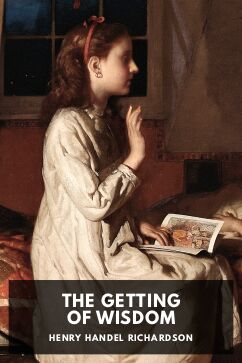The Getting of Wisdom

Description
Twelve-year-old Laura and her three younger siblings live in rural Victoria, Australia. Their father has died, and their mother supports the family through sewing and embroidery. With financial support from her godmother, Laura is sent to the prestigious Ladies’ College, a girls’ boarding school in the state’s capital city of Melbourne. There, she is exposed to the prejudice of her wealthier and more worldly peers, and learns to be ashamed of her homespun background, especially of her mother’s “working with her hands.” What kind of wisdom will she gain in her new environment, whose reigning values are appearance and conformity?
The Getting of Wisdom is a coming-of-age novel that depicts the material and moral constrictions of late nineteenth-century Australian society, including some of its racist attitudes. Its main subjects are class prejudice, lying, and social “pretending.”
“Henry Handel Richardson” was the pseudonym of author Ethel Florence Lindesay Richardson, who wrote that The Getting of Wisdom was a “very fair account” of her own years at Melbourne’s Presbyterian Ladies’ College. She claimed that the school refused her entry when she returned to visit in 1912, due to her representation of it in the novel.
H. G. Wells admired the work as one of the best school stories he had encountered. Australian feminist Germaine Greer and critic Catherine Pratt would later compare it unfavorably with James Joyce’s semi-autobiographical novel A Portrait of the Artist as a Young Man, which also details its protagonist’s years at a boarding school. While Greer dismisses some of Richardson’s stated notions of Laura as a young artist, Pratt concedes to The Getting of Wisdom a place in the Künstlerroman genre, noting the influence of Norwegian author Bjørnstjerne Bjørnson’s novel The Fisher Girl on Richardson.
The Getting of Wisdom also has a debt to Nietzsche, made explicit in some chapter epigraphs and its major theme of truth, lies, and “stories.” Despite both this and its elements of fictionalized memoir and social criticism, it is often classified as a children’s book.
Read free
This ebook is thought to be free of copyright restrictions in the United States. It may still be under copyright in other countries. If you’re not located in the United States, you must check your local laws to verify that this ebook is free of copyright restrictions in the country you’re located in before accessing, downloading, or using it.

Download for ereaders
-
Compatible epub — All devices and apps except Kindles and Kobos.
-
azw3 — Kindle devices and apps. Also download the Kindle cover thumbnail to see the cover in your Kindle’s library. Despite what you’ve been told, Kindle does not natively support epub. You may also be interested in our Kindle FAQ.
-
kepub — Kobo devices and apps. You may also be interested in our Kobo FAQ.
-
Advanced epub — An advanced format that uses the latest technology not yet fully supported by most ereaders.
Read online
A brief history of this ebook
More details
Sources
Transcriptions
Page scans
Improve this ebook
Anyone can contribute to make a Standard Ebook better for everyone!
To report typos, typography errors, or other corrections, see how to report errors.
If you’re comfortable with technology and want to contribute directly, check out this ebook’s GitHub repository and our contributors section.
You can also donate to Standard Ebooks to help fund continuing improvement of this and other ebooks.